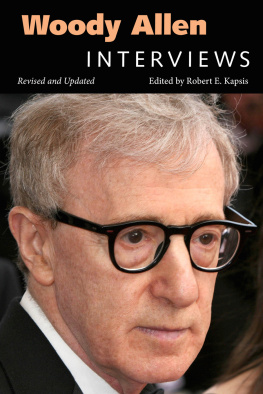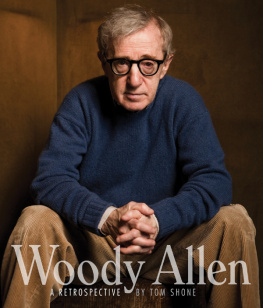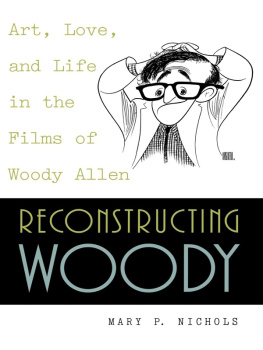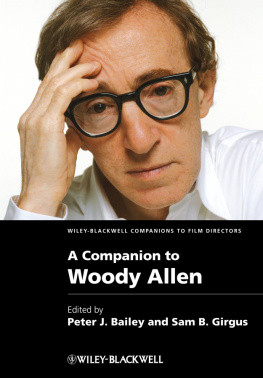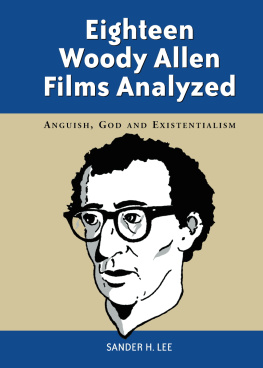BRANDEIS SERIES IN AMERICAN JEWISH HISTORY, CULTURE, AND LIFE
Jonathan D. Sarna, Editor~Sylvia Barack Fishman, Associate Editor
For a complete list of books that are available in the series, visit www.upne.com
Vincent Brook and
Marat Grinberg, editors
Woody on Rye: Jewishness in the Films and Plays of Woody Allen
Mark Cohen
Overweight Sensation: The Life and Comedy of Allan Sherman
David E. Kaufman
Jewhooing the Sixties: American
Celebrity and Jewish Identity Sandy
Koufax, Lenny Bruce, Bob Dylan, and Barbra Streisand
Jack Wertheimer, editor
The New Jewish Leaders: Reshaping the American Jewish Landscape
Eitan P. Fishbane and
Jonathan D. Sarna, editors Jewish Renaissance and Revival in America
Jonathan B. Krasner
The Benderly Boys and American Jewish Education
Derek Rubin, editor
Promised Lands: New Jewish American
Fiction on Longing and Belonging
Susan G. Solomon
Louis I. Kahns Jewish Architecture:
Mikveh Israel and the Midcentury
American Synagogue
Amy Neustein, editor
Tempest in the Temple: Jewish Communities and Child Sex Scandals
Jack Wertheimer, editor
Learning and Community: Jewish Supplementary Schools in the Twenty-first Century
Carole S. Kessner
Marie Syrkin: Values Beyond the Self
Leonard Saxe and Barry Chazan
Ten Days of Birthright Israel:
A Journey in Young Adult Identity
Jack Wertheimer, editor
Imagining the American Jewish Community
Murray Zimiles
Gilded Lions and Jeweled Horses: The Synagogue to the Carousel
Marianne R. Sanua
Be of Good Courage: The American Jewish Committee, 19452006
Hollace Ava Weiner and Kenneth D. Roseman, editors
Lone Stars of David: The Jews of Texas
Jack Wertheimer, editor
Jewish Education in an Age of Choice
Edward S. Shapiro
Crown Heights: Blacks, Jews, and the 1991 Brooklyn Riot
Woody On Rye
JEWISHNESS IN THE FILMS AND PLAYS OF WOODY ALLEN
EDITED BY
VINCENT BROOK AND MARAT GRINBERG
Brandeis University Press~Waltham, Massachusetts
Brandeis University Press
An imprint of University Press of New England
www.upne.com
2014 Brandeis University
All rights reserved
For permission to reproduce any of the material in this book, contact Permissions, University Press of New England, One Court Street, Suite 250, Lebanon NH 03766; or visit www.upne.com.
Library of Congress Cataloging-in-Publication Data
Woody on rye : Jewishness in the films and plays of Woody Allen/edited by Vincent Brook and Marat Grinberg.
pages cm. (Brandeis series in American Jewish history, culture, and life)
ISBN 9781611684797 (cloth : alk. paper)
ISBN 9781611684803 (pbk. : alk. paper)
ISBN 9781611684810 (ebook)
1. Allen, WoodyCriticism and interpretation.
2. Jews in popular cultureUnited States.
3. Popular cultureReligious aspectsJudaism.
I. Brook, Vincent, 1946 editor of compilation.
II. Grinberg, Marat, 1977 editor of compilation.
PN 1998.3. A 45 W 76 2013
791.43092dc23 2013017426
CONTENTS
Woody Allen Retires [along with the Pope].
Two World Religions Now Leaderless!
~Jewish Journal, 2013 Purim issue headline
VINCENT BROOK AND MARAT GRINBERG
Introduction
You dont have to be Jewish to appreciate Woody Allen, but it helps. Thus quipped Foster Hirsch in the Jewish Connection chapter of his 1981 study of Allens films, Love, Sex, Death, and the Meaning of Life. Yet Rubin-Dorskys analysis ends with Deconstructing Harry (1997), thus leaving Jewishness in Allens overall body of work, especially his more recent efforts, still largely unexplored.
Hirsch himself, in subsequent updates of Love, Sex, Death, and the Meaning of Life in 1990 and 2001, has left his original Jewish Connection chapter unchanged. Mashey Bernsteins 1996 essay My Worst Fears Realized: Woody Allen and the Holocaust, in an exhaustive list of Holocaust references in Allens films, similarly stops at 1992s Shadows and Fog.
This puts serious investigation of Jewishness in Allens pre- and postscandal output about where it was in 1993. In addition to Hirschs chapter and the aforementioned essays, this includes the following: Gerald Masts Woody Allen: The Neurotic Jew as American Clown (1987); Richard Feldsteins Displaced Feminine Representation in Woody Allens Cinema (1989); Richard Freadmans Love among the Stereotypes, or Why Woodys Women Leave (1993); Sam B. Girguss Philip Roth and Woody Allen: Freud and the Humor of the Repressed (1993); the lengthy Allen section in David Desser and Lester Friedmans American-Jewish Filmmakers (1993); and Thomas Kinnes German dissertation Elemente jdischer Tradition im Werk Woody Allens (Traditional Jewish elements in Woody Allens work; also 1993).
The lack of a more all-inclusive discussion of Jewishness in Allens work has not gone unnoticed. Danielle Berrin, in a review of a 2011 PBS documentary on Allens career, found it curious that for all the Jewish men involved with the project [director Robert Weide, executive producer Bret Ratner, and financier Fisher Williams], there is little in the film that deals with Allens Jewish identity. And given that its a recurrent theme in his work, both in subtle and not-so-subtle ways, the disregard feels like a gap.especially, is Allens treatment of women Jewish and non-Jewish, on-screen and off. One section of Woody on Rye is thus devoted to womens issues in Allens body of work. And on the womens question, as on the Jewish question, Hirsch provides a lead-in.
What, again? a friend questioned his updated coverage of Allens films in 2001. Why do you want to write about that pathetic creep? another friend complained, while a third made an unprintable comment. All three anti-Allenites were women, from which a male friend extrapolated, Women cant forgive him [for the Previn affair], guys can.
Talking Points
Allens sexual problematic in general his most popular theme Hirsch deconstructs at length.
Richard Freadman adds a Pygmalion-like twist to Allens shiksa complex.
A corollary of the shiksa complex and, for Hirsch, the central link to Jewishness in Allens (prescandal) work is Ruth Wisses concept of the schlemiel as [modern] hero.
Bleiweiss, as his essay title indicates, grounds Allens Jewish humor in its self-deprecatory aspect. As outlined in Freuds Jokes and Their Relation to the Unconscious, and variously reinterpreted by subsequent theorists, self-deprecation can be deployed as a defense mechanism: laughing to keep from crying.
Gerald Mast makes the historical case for Allen as the first great American film-clown for whom being Jewish was not simply a hereditary accident but a way of life.
Such de-Judaization had become commonplace, if not obligatory, ever since Hollywoods so-called Great Retreat from Jewish representation, in the face of rising anti-Semitism, in the 1930s.
Kinnes dissertation, befitting a study devoted exclusively to Jewish elements in Allens oeuvre, offers the most extensive treatment to date of the writer-director-actors Jewish influences. Starting with the Judaic ur-texts, Kinne counters the Talmudic injunction All that is not levity is Torah with Dov Langs assessment of the Scriptures as possessing a humor of irony, of another way of telling the truth, of putting matters right. As Boris (Allen) states in


